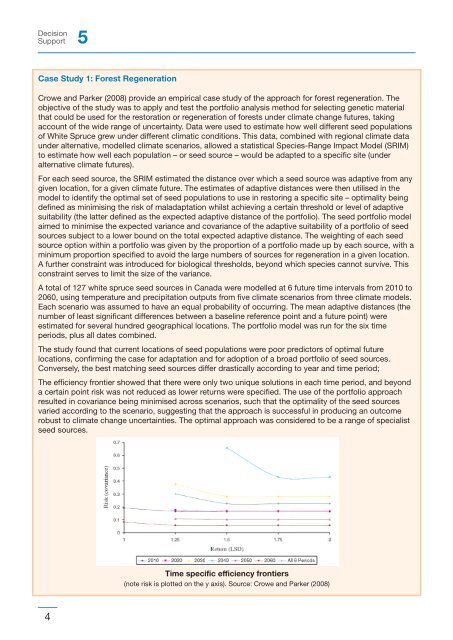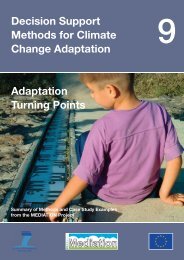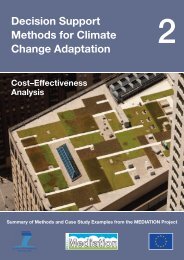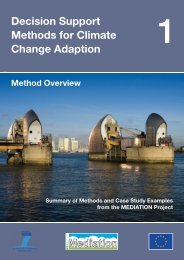Download all Technical Policy Briefing Notes in a single ... - Mediation
Download all Technical Policy Briefing Notes in a single ... - Mediation
Download all Technical Policy Briefing Notes in a single ... - Mediation
- No tags were found...
Create successful ePaper yourself
Turn your PDF publications into a flip-book with our unique Google optimized e-Paper software.
DecisionSupport 5Case Study 1: Forest RegenerationCrowe and Parker (2008) provide an empirical case study of the approach for forest regeneration. Theobjective of the study was to apply and test the portfolio analysis method for select<strong>in</strong>g genetic materialthat could be used for the restoration or regeneration of forests under climate change futures, tak<strong>in</strong>gaccount of the wide range of uncerta<strong>in</strong>ty. Data were used to estimate how well different seed populationsof White Spruce grew under different climatic conditions. This data, comb<strong>in</strong>ed with regional climate dataunder alternative, modelled climate scenarios, <strong>all</strong>owed a statistical Species-Range Impact Model (SRIM)to estimate how well each population – or seed source – would be adapted to a specific site (underalternative climate futures).For each seed source, the SRIM estimated the distance over which a seed source was adaptive from anygiven location, for a given climate future. The estimates of adaptive distances were then utilised <strong>in</strong> themodel to identify the optimal set of seed populations to use <strong>in</strong> restor<strong>in</strong>g a specific site – optimality be<strong>in</strong>gdef<strong>in</strong>ed as m<strong>in</strong>imis<strong>in</strong>g the risk of maladaptation whilst achiev<strong>in</strong>g a certa<strong>in</strong> threshold or level of adaptivesuitability (the latter def<strong>in</strong>ed as the expected adaptive distance of the portfolio). The seed portfolio modelaimed to m<strong>in</strong>imise the expected variance and covariance of the adaptive suitability of a portfolio of seedsources subject to a lower bound on the total expected adaptive distance. The weight<strong>in</strong>g of each seedsource option with<strong>in</strong> a portfolio was given by the proportion of a portfolio made up by each source, with am<strong>in</strong>imum proportion specified to avoid the large numbers of sources for regeneration <strong>in</strong> a given location.A further constra<strong>in</strong>t was <strong>in</strong>troduced for biological thresholds, beyond which species cannot survive. Thisconstra<strong>in</strong>t serves to limit the size of the variance.A total of 127 white spruce seed sources <strong>in</strong> Canada were modelled at 6 future time <strong>in</strong>tervals from 2010 to2060, us<strong>in</strong>g temperature and precipitation outputs from five climate scenarios from three climate models.Each scenario was assumed to have an equal probability of occurr<strong>in</strong>g. The mean adaptive distances (thenumber of least significant differences between a basel<strong>in</strong>e reference po<strong>in</strong>t and a future po<strong>in</strong>t) wereestimated for several hundred geographical locations. The portfolio model was run for the six timeperiods, plus <strong>all</strong> dates comb<strong>in</strong>ed.The study found that current locations of seed populations were poor predictors of optimal futurelocations, confirm<strong>in</strong>g the case for adaptation and for adoption of a broad portfolio of seed sources.Conversely, the best match<strong>in</strong>g seed sources differ drastic<strong>all</strong>y accord<strong>in</strong>g to year and time period;The efficiency frontier showed that there were only two unique solutions <strong>in</strong> each time period, and beyonda certa<strong>in</strong> po<strong>in</strong>t risk was not reduced as lower returns were specified. The use of the portfolio approachresulted <strong>in</strong> covariance be<strong>in</strong>g m<strong>in</strong>imised across scenarios, such that the optimality of the seed sourcesvaried accord<strong>in</strong>g to the scenario, suggest<strong>in</strong>g that the approach is successful <strong>in</strong> produc<strong>in</strong>g an outcomerobust to climate change uncerta<strong>in</strong>ties. The optimal approach was considered to be a range of specialistseed sources.Time specific efficiency frontiers(note risk is plotted on the y axis). Source: Crowe and Parker (2008)4





